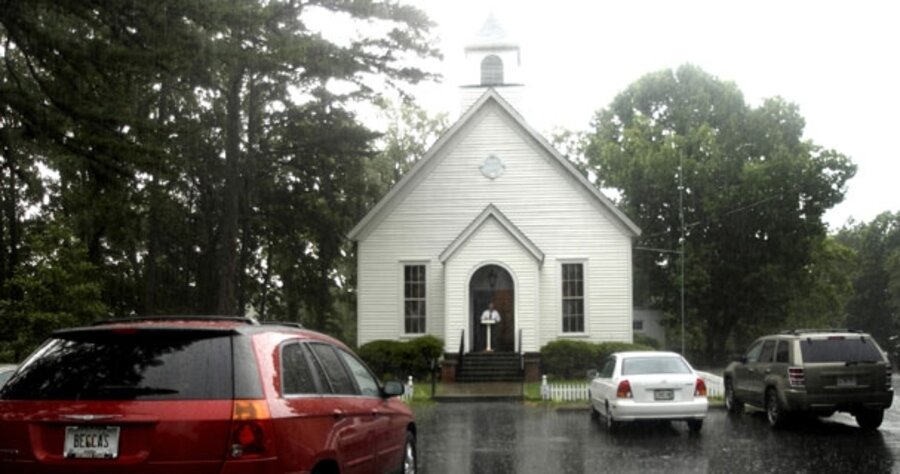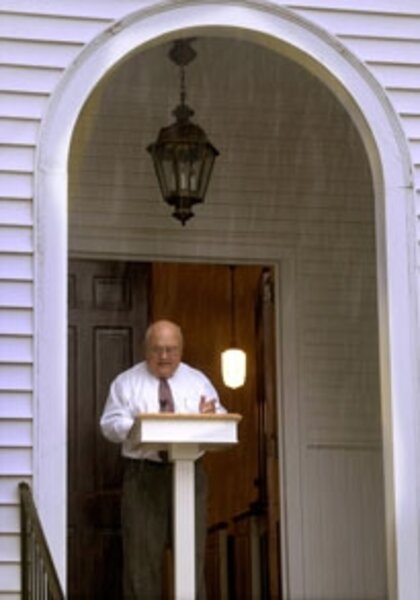A Georgia church tries drive-in worship
Loading...
| Marietta, Ga.
The brown and white beagle peers intently at her owner, watching as he swigs V-8 juice and dials his car radio to 1640 AM. On an ordinary Sunday morning in Marietta, Ga., Barry Hopkins would be getting ready for church. Today, dressed in shorts and an Atlanta Braves T-shirt, he’s already there – in his car.
A few vehicles dot the parking lot of New Hope Methodist Church in suburban Atlanta, but there’s no sound except the rumble of idling motors. Slow rain becomes a torrent, blowing in wide sheets, obscuring the pastor standing on the church steps as he delivers his sermon. Drivers flick their windshield wipers to life and stare straight ahead. They won’t leave their steel cocoons any time soon. They won’t need to: The sermon booms from their radios like Carrie Underwood.
Drive-ins have given us movies delivered to our cars with popcorn and notions of front-seat romance. They have given us fries and malts delivered by teens on roller skates. Now they’re giving us the word of God, or at least of preachers, delivered out of our dashboards in the hope of attracting a new multitude of worshipers.
Across the country, a handful of churches are trying to unite two fundamental forces – religion and Americans’ love affair with the automobile – to offset the dearth of people sitting in pews.
Usually, as here at New Hope, attendees can be as involved or uninvolved as they want. Either way is just fine with the Rev. Norman Markle. He stands in the outdoor alcove that is his pulpit and preaches, hoping his message carries clearly through his lapel microphone.
“A lot of people still feel the only way they’ll be accepted is if they come to church with a suit and tie,” he says. “But that’s changed. If we don’t change, we’re losing out to the new churches.”
•••
Tucked inside his office after the sermon, Mr. Markle peels open a McDonald’s wrapper and spreads grape jelly over a sausage biscuit. His regular indoor service begins soon, and for this one, he’ll wear his starched white robe emblazoned with a gold cross. It’ll be a completely different sermon. The drive-in service is only 45 minutes – people won’t sit in their cars much longer. In the church, with its pine floors and luminous stained-glass windows, Markle can preach as long as he likes – usually about two hours.
Markle’s dream of a drive-in church was inspired by one in Pennsylvania. While the concept has been around since the days of tail fins – the Crystal Cathedral in southern California began holding drive-in services in the 1950s – New Hope is the only one doing it in the Atlanta area.
The parishioners are predominantly over 65, holding ideals taught by their parents, including dressing up on Sundays. But with scattered signs proclaiming, “Worship in Your Car, Just as You Are,” times are changing for the 152-year-old congregation and its 88 members.
On sunny days, families listen to the service from lawn chairs while children play nearby. Today, Markle is pleased at the sight of five new cars and four familiar ones. Still, rain may have kept some people away. “I don’t care about the numbers,” he says, looking down at his desk. “The DS [district superintendent] asks how many I gained. Well, I gained eight but I lost nine.”
He’s proud of the “great little church” he’s led for 12 years and isn’t worried about the mixed reactions the new service has generated. “Some people say this isn’t really church, but what is the church? It’s the people,” he says. “We have to figure out a way to bring people in and not make them feel uncomfortable.”
The laid-back atmosphere works for Wayne Shumake and his wife, Nelda. They attend a drive-in church every year while vacationing in Daytona, Fla., and are thrilled there’s one close to home. This is their first time at New Hope, and they say they’ll be back. “When we’re at the beach, we go in shorts,” says Mr. Shumake, wearing a Hawaiian shirt and sandals. “But I grew up in the country. I’m old school. You wore your Sunday best to show respect to the Lord.”
More than just casual clothing lies behind the appeal of drive-in churches, though. The Rev. Verlyn Verbrugge, pastor of Woodland Drive-In Church in Grand Rapids, Mich., says they are also convenient for people who don’t like to socialize or who struggle with health issues.
Unlike New Hope, Mr. Verbrugge’s church holds no indoor services. Founded in 1970, it has grown from 35 cars to 80 and is self-supporting. Visitors are given envelopes to make prayer requests, which often include a contribution. Still, he insists on keeping some traditions – communion is held in the fellowship hall, and people are no longer allowed to honk horns or flash headlights in lieu of amens. He admits there are disadvantages.
“There’s no sense of community among the members,” he says. “No singing, no midweek activities. But the type of people who come to drive-in church aren’t looking for that. Our main purpose is as a transition church. If we can bring a person to a relationship with Christ and they move on, we’ve fulfilled our purpose.”
Yet the idea still seems almost quaint. Why would anyone drive across town to sit in a parking lot when they can be at home and listen to the sermon on the radio or perhaps watch it online?
For one thing, they may not be able to hear it: The radio signal for most of these churches isn’t as strong as Solomon. The broadcast range for New Hope, which is surrounded by car dealerships and storage buildings, is a scant three miles – and even then the sermon might be interrupted by local sportscasts.
For another, some people see sitting in the church parking lot as a tentative step toward traditional worship, giving them a sense of commitment while still experiencing church on their own terms. “It gets people to the building, even if it doesn’t get them inside the door,” says Tona Hangen, a religious-broadcasting expert at Worcester State College in Massachusetts. “It’s easy to tune into something else, but if you’re in the parking lot, you’re committed to listening.”
•••
The second service is still 20 minutes away, but Markle has abandoned his breakfast and is greeting the drive-in worshipers and welcoming his regular congregation as they pour inside, shaking umbrellas and shedding raincoats.
Some people, like Mr. Hopkins – a member for 15 years and a singer in the choir – enjoy the drive-in services so much they stay for the traditional service as well. Hopkins says he, and others, were skeptical of the idea but were moved by Markle’s enthusiasm. Most have warmed to the idea, but it’s hard to tell if the new format will be successful. Markle says he’ll continue until cold weather sets in, then reevaluate.
Outside, the drive-in crowd is heading back into the Sturm und Drang of city traffic and a fast-food world. Inside, worshipers find their seats and talk falls to a hush.
Markle looks out over the sea of suits and ties, starched dresses and patent leather shoes, opens his maroon Bible, and begins. As long as there are people, there will be a church. And as long as there’s a church, he’ll be there every Sunday, indoors or outdoors, rain or shine.






